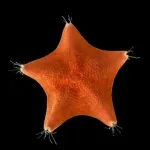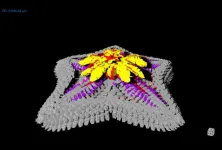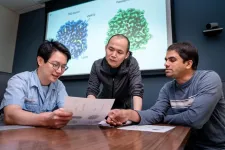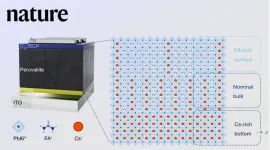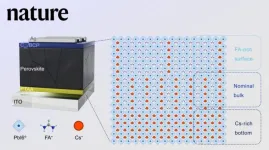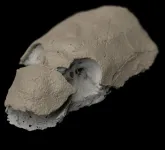(Press-News.org) Researchers have genetically engineered the first mice that get a human-like form of COVID-19, according to a study published online November 1 in Nature.
Led by researchers from NYU Grossman School of Medicine, the new work created lab mice with human genetic material for ACE2 – a protein snagged by the pandemic virus so it can attach to human cells as part of the infection. The mice with this genetic change developed symptoms similar to young humans infected with the virus causing COVID-19, instead of dying upon infection as had occurred with prior mouse models.
“That these mice survive creates the first animal model that mimics the form of COVID-19 seen in most people – down to the immune system cells activated and comparable symptoms,” said senior study author Jef Boeke, the Sol and Judith Bergstein Director of the Institute for Systems Genetics at NYU Langone Health. “This has been a major missing piece in efforts to develop new drugs against this virus.”
“Given that mice have been the lead genetic model for decades,” added Boeke, “there are thousands of existing mouse lines that can now be crossbred with our humanized ACE2 mice to study how the body reacts differently to the virus in patients with diabetes or obesity, or as people age.”
Problem of Large DNA
The new study revolves around a new method to edit DNA, the 3 billion “letters” of the genetic code that serve as instructions for building our cells and bodies.
While famous techniques like CRISPR enable the editing of DNA editing just one or a few letters at a time, some challenges require changes throughout genes that can be up to 2 million letters long. In such cases, it may be more efficient to build DNA from scratch, with far-flung changes made in large swaths of code pre-assembled and then swapped into a cell in place of its natural counterpart. Because human genes are so complex, Boeke’s lab first developed its “genome writing” approach in yeast, one-celled fungi that share many features with human cells but that are simpler and easier to study.
More recently, Boeke’s team adapted their yeast techniques to the mammalian genetic code, which is made up of not just of genes that encode proteins, but also of many switches that turn on different genes at different levels in different cell types. By studying this poorly understood “dark matter” that regulates genes, the research team was able to design living mice with cells that had more human-like levels of ACE gene activity for the first time. The study authors used yeast cells to assemble DNA sequences of up to 200,000 letters in a single step, and then delivered these “naked” DNAs into mouse embryonic stem cells using their new delivery method, mSwAP-In.
Overcoming the size limits of past methods, mSwAP-In delivered a humanized mouse model of COVID-19 pathology by “overwriting” 72 kilobases (kb) of mouse Ace2 code with 180 kb of the human ACE2 gene and its regulatory DNA.
To accomplish this cross-species swap, the study method cut into a key spot in the DNA code around the natural gene, swapped in a synthetic counterpart in steps, and with each addition, added a quality control mechanism so that only cells with the synthetic gene survived. The research team then worked with Sang Yong Kim at NYU’s Rodent Genome Engineering Lab using a stem cell technique called “tetraploid complementation” to create a living mouse whose cells included the overwritten genes.
In addition, the researchers had previously designed a synthetic version of the gene Trp53, the mouse version of the human gene TP53, and swapped it into mouse cells. The protein encoded by this gene coordinates the cell’s response to damaged DNA, and can even instruct cells containing it to die to prevent the build-up of cancerous cells. When this “guardian of the genome” itself becomes faulty, it is a major contributor to human cancers.
Whereas the ACE2 experiments had swapped in an unchanged version of a human gene, the synthetic, swapped-in Trp53 gene had been designed to no longer include a combination of molecular code letters – cytosine (C) next to guanine (G) – known to be vulnerable to random, cancer-causing changes. The researchers overwrote key CG “hotspots” with code containing a different DNA letter in adenine (A).
“The AG switch left the gene’s function intact, but lessened its vulnerability to mutation, with the swap predicted to lead to a 10-to-50 fold lower mutation rate,” said first author Weimin Zhang, PhD, a post-doctoral scholar in Boeke’s lab. “Our goal is to demonstrate in a living test animal that this swap leads to fewer mutations and fewer resulting tumors, and those experiments are being planned.”
***
Along with Boeke and Zhang, NYU Langone study authors were Ran Brosh, Aleksandra Wudzinska, Yinan Zhu, Noor Chalhoub, Emily Huang, and Hannah Ashe in the Institute for Systems Genetics and Department of Biochemistry & Molecular Pharmacology; Ilona Golynker, Lucia Carrau, Payal Damani-Yokota, Camille Khairallah, Kamal Khanna, and Benjamin tenOever in the Department of Microbiology; and Matthew Maurano and Sang Yong Kim in the Department of Pathology.
The work was funded by National Institutes of Health CEGS grant 1RM1HG009491 and Perlmutter Cancer Center Support Grant P30CA016087. Boeke is a founder of CDI Labs, Inc., a founder of Neochromosome, Inc.; a founder of ReOpen Diagnostics, LLC, and serves or has served on the scientific advisory boards of Logomix Inc., Modern Meadow, Inc., Rome Therapeutics, Inc., Sample6, Inc., Sangamo, Inc., Tessera Therapeutics, Inc. and the Wyss Institute. Boeke also receives consulting fees and royalties from OpenTrons, and holds equity in the company. These relationships are managed in accordance with the policies of NYU.
END
First mice engineered to survive COVID-19 like young, healthy humans
Model offers new ways to study disease impact and treatment approaches
2023-11-01
ELSE PRESS RELEASES FROM THIS DATE:
As people live longer, family caregivers face financial challenges
2023-11-01
PHILADELPHIA (November 1, 2023) – Many people overlook the short- and long-term costs of financial caregiving, a growing problem that financial advisors and employers can help address, according to a new report by the TIAA Institute and the University of Pennsylvania School of Nursing (Penn Nursing).
One in five adults now provide uncompensated care to loved ones with health problems, and the report provides a comprehensive compilation of insights and research that underscores how the caregivers face a ...
Human mini guts reveal new insights into the process leading to Cronkhite-Canada syndrome and potential new therapies
2023-11-01
Researchers at Baylor College of Medicine and collaborating institutions working with human intestinal organoids, also called mini guts, have shed new light on the potential causes of Cronkhite-Canada syndrome, a rare condition characterized by abundant non-cancerous growths or polyps in the intestine and other symptoms such as hair and nail loss and changes in skin pigmentation. Published in The Journal of Clinical Investigation, the study is the first to show a connection between high polyp proliferation and increased levels of serotonin produced by the intestinal epithelium.
The findings suggest a potential new approach to treat this disease with serotonin ...
Long presumed to have no heads at all, sea stars may be nothing but
2023-11-01
For centuries, naturalists have puzzled over what might constitute the head of a sea star, commonly called a “starfish.” When looking at a worm, or a fish, it’s clear which end is the head and which is the tail. But with their five identical arms — any of which can take the lead in propelling sea stars across the seabed — it’s been anybody’s guess how to determine the front end of the organism from the back. This unusual body plan has led many to conclude that sea stars perhaps don’t have a head at all.
But ...
Starfish body is a head, say scientists
2023-11-01
EMBARGOED: Not for Release Until 01 November 2023 at 16:00 (London time)
The bodies of starfish and other echinoderms are more like heads, according to new research involving the University of Southampton.
The research, published today [1 November] in Nature, helps to answer the mystery of how these creatures evolved their distinctive star-shaped body, which has long puzzled scientists.
Echinoderms are a group of animals that includes starfish (or sea stars), sea urchins, and sand dollars. They have a unique ‘fivefold symmetric’ body plan, which means ...
Scientists reveal structures of neurotransmitter transporter
2023-11-01
(Memphis, Tenn – November 1, 2023) Neurons talk to each other using chemical signals called neurotransmitters. Scientists at St. Jude Children’s Research Hospital have drawn on structural biology expertise to determine structures of vesicular monoamine transporter 2 (VMAT2), a key component of neuronal communication. By visualizing VMAT2 in different states, scientists now better understand how it functions and how the different shapes the protein takes influence drug binding — critical information for ...
Heterogeneity of Earth’s mantle may be relics of Moon formation
2023-11-01
An interdisciplinary international research team has recently discovered that a massive anomaly deep within the Earth’s interior may be a remnant of the collision about 4.5 billion years ago that formed the Moon.
This research offers important new insights not only into Earth’s internal structure but also its long-term evolution and the formation of the inner solar system.
The study, which relied on computational fluid dynamics methods pioneered by Prof. DENG Hongping of the Shanghai Astronomical Observatory (SHAO) of ...
Study reveals location of starfish’s head
2023-11-01
If you put a hat on a starfish, where would you put it? On the center of the starfish? Or on the point of an arm and, if so, which one? The question is silly, but it gets at serious questions in the fields of zoology and developmental biology that have perplexed veteran scientists and schoolchildren in introductory biology classes alike: Where is the head on a starfish? And how does their body layout relate to ours?
Now, a new Stanford study that used genetic and molecular tools to map out the body regions of starfish – by creating a 3D atlas of their gene ...
Scientists propose perovskite films homogenizing strategy to increase conversion efficiency
2023-11-01
In a study published in Nature, researchers from the Hefei Institutes of Physical Science (HFIPS) of the Chinese Academy of Sciences have proposed a new and promising method of fabricating homogenized perovskite films for solar cells. The process involves inhibiting phase segregation caused by internal cation inhomogeneity to increase conversion efficiency to 26.1%, thus tying the existing record.
Their work was also featured as a Nature Editor’s Pick.
For solar cells, an important alternative energy ...
Scientists propose perovskite film homogenizing strategy to increase conversion efficiency
2023-11-01
In a study published in Nature, researchers from the Hefei Institutes of Physical Science (HFIPS) of the Chinese Academy of Sciences have proposed a new and promising method of fabricating homogenized perovskite films for solar cells. The process involves inhibiting phase segregation caused by internal cation inhomogeneity to increase conversion efficiency to 26.1%, thus tying the existing record.
Their work was also featured as a Nature Editor's Pick.
For solar cells, an important alternative energy source, the pursuit of higher conversion efficiency and the attempt to keep the cells table as long as possible are core issues that scientists and engineers all over the world are ...
How the fish got its shoulder
2023-11-01
A new analysis of the bones and muscles in ancient fish gives new clues about how the shoulder evolved in animals – including us.
The shoulder girdle – the configuration of bones and muscles that in humans support the movement of the arms – is a classic example of an evolutionary ‘novelty’. This is where a new anatomical feature appears without any obvious precursors; where there is no smoking gun of which feature clearly led to another.
The new research, which draws together a range of evolutionary investigation techniques including fossils, ...
LAST 30 PRESS RELEASES:
Pew funds 7 new biomedical research collaborations
The ERC selects 349 mid-career researchers for €728 million in Consolidator Grants
ERC Consolidator Grant awarded to CISPA researcher Rayna Dimitrova
Antimicrobial effects of Syzygium aromaticum and Salvadora persica against common peri-implantitis pathogens in vitro
EVs pose no greater risk to pedestrians than conventional vehicles
Modeling microplastic accumulation under the ocean surface
Pompeii offers insights into ancient Roman building technology
University of Utah engineers give a bionic hand a mind of its own
Transient and long-term risks of common physical activities in people with low back pain
Health care contact days in older adults with metastatic cancer
Brain resilience science reshapes psychiatry from treating illness to building strength
An assessment of the antidepressant potential of deramciclane in two animal tests
Pitt and UPMC study finds epigenetic signature of pediatric traumatic brain injury, paves way for precision recovery tools
Brain discovery opens door to earlier detection of metabolic syndrome in women
SwRI-led study provides insight into oscillations in solar flares
Announcing the third cohort of the Hevolution/AFAR new investigator awards in aging biology and geroscience research
GeoFlame VISION: Using AI and satellite imagery to predict future wildfire risk
Nationwide study suggests that water treatment methods may impact the risk of legionnaires’ disease
Oyster larvae on drugs move slowly and are stressed
Targeting a specific brain circuit may help prevent opioid relapse, WSU study finds
Tec-Dara combination offers substantial improvement over standard second-line therapies for relapsed or refractory multiple myeloma
Improving treatment for an autoimmune bleeding condition
Drug reduced need for blood transfusions during hospitalization for non-cardiac surgery
Novel agent ianalumab added to standard therapy extends time to treatment failure in patients with previously treated immune thrombocytopenia
Pirtobrutinib outperforms bendamustine plus rituximab for previously untreated CLL/SLL
Online tracking and privacy on hospital websites
A freely available tool to document wartime destruction
Residential solar panels can raise electricity rates
Scientists use synthetic platelets as ‘Trojan horse’ drug-delivery system
Cooperative Intermolecular Interactions Regulate Supramolecular Polymer Assembly
[Press-News.org] First mice engineered to survive COVID-19 like young, healthy humansModel offers new ways to study disease impact and treatment approaches

